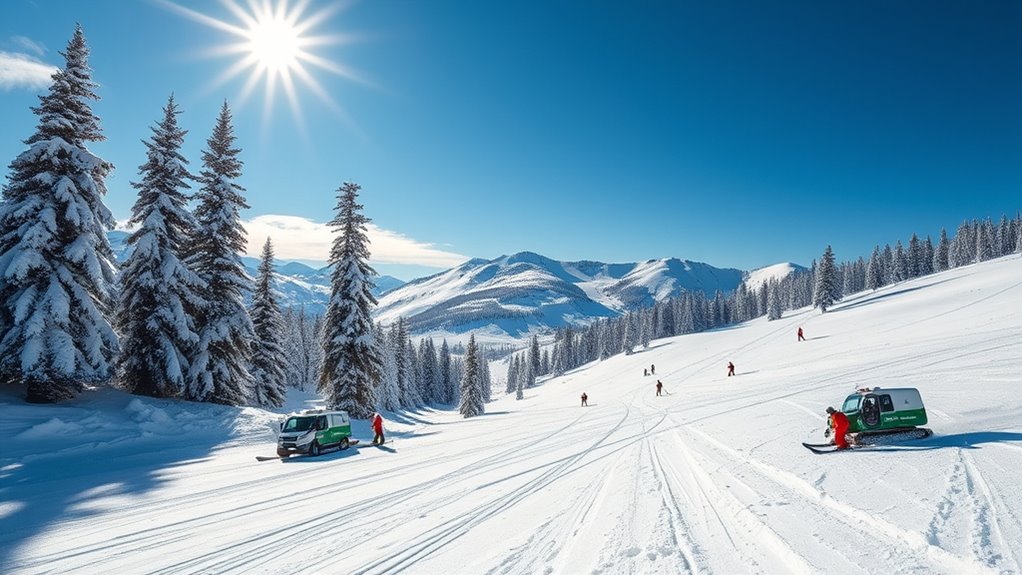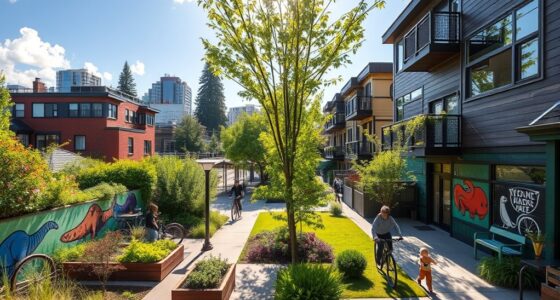To pursue carbon-neutral skiing in Aspen Snowmass, you can support initiatives like renewable energy use, including solar and wind power, to reduce the resort’s carbon footprint. Opt for eco-friendly transport options such as shuttles, biking, or walking. Additionally, contributing to or advocating for sustainable infrastructure and conservation efforts helps protect the environment. If you want to explore how these strategies are shaping the future of winter sports, there’s more to discover.
Key Takeaways
- Aspen Snowmass invests in renewable energy sources like solar and wind to power ski operations and reduce carbon emissions.
- The resort utilizes eco-friendly snowmaking technologies that minimize water and energy use while maintaining quality.
- Electric shuttle buses and bike-sharing programs decrease transportation-related carbon footprint for visitors.
- Aspen Snowmass participates in reforestation and renewable energy projects to offset operational greenhouse gases.
- Sustainable infrastructure, including green architecture and eco-conscious materials, supports long-term carbon neutrality goals.
The Environmental Impact of Ski Resorts

Have you ever wondered how ski resorts impact the environment? Your presence on the slopes can affect alpine biodiversity by disrupting local habitats and wildlife. Construction of ski runs and lifts often leads to habitat fragmentation, threatening plant and animal species that thrive in mountain ecosystems. Additionally, ski resorts can impact snowpack preservation; artificial grooming and deforestation accelerate snow melt, reducing the natural snow cover that sustains water sources downstream. This loss of snowpack not only harms ecosystems but also diminishes the scenic beauty that draws visitors. Recognizing these impacts is vital for developing sustainable practices. By minimizing disruption and protecting natural snow cover, ski resorts can help preserve the delicate balance of mountain environments for future generations. Implementing environmentally friendly infrastructure can further reduce their ecological footprint and promote conservation efforts.
Initiatives Toward Renewable Energy Adoption
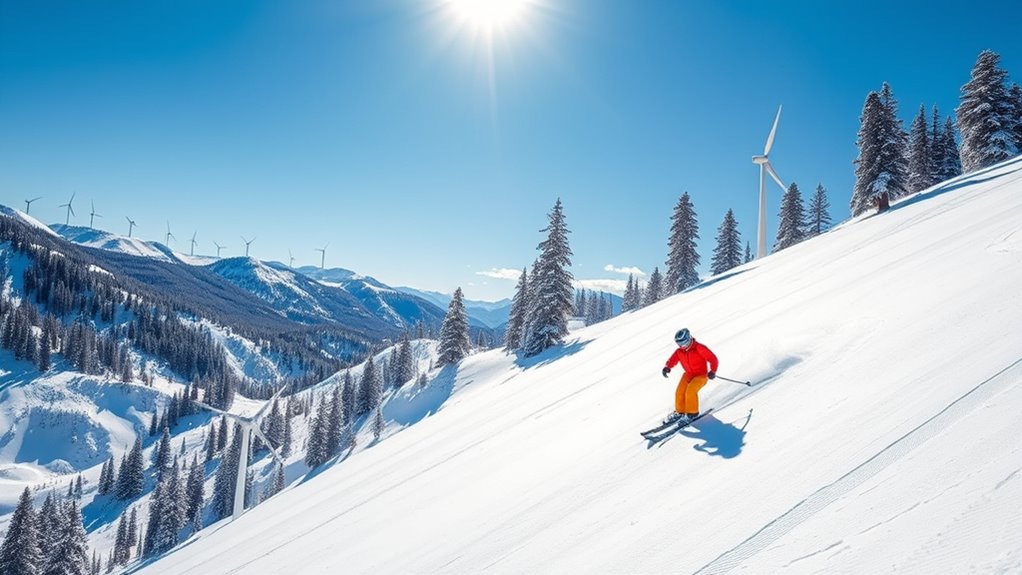
You can see Aspen Snowmass actively embracing renewable energy by integrating solar power systems across their facilities. Wind energy projects are also underway to further reduce reliance on fossil fuels. These initiatives demonstrate the resort’s commitment to sustainable practices and cutting emissions. The use of solar panels with high efficiency ratings underscores their dedication to eco-friendly solutions.
Solar Power Integration
To move toward true carbon neutrality, Aspen Snowmass has actively integrated solar power into its energy mix. By installing solar panels across the resort, you harness the sun’s energy to diminish reliance on fossil fuels. Energy storage solutions ensure you can use solar power even when the sun isn’t shining, increasing efficiency and stability. This integration helps lower carbon emissions and promotes sustainable tourism. Here are some key aspects:
- Solar panels on rooftops and open spaces maximize sunlight capture
- Battery systems store excess energy for cloudy days or nighttime use
- Investment in advanced energy storage enhances reliability
- Reduced greenhouse gases contribute to cleaner air
- Renewable energy advancements support long-term sustainability goals
You’ll notice the resort’s commitment to reducing its carbon footprint through these innovative, eco-friendly measures, complemented by ongoing efforts in fraud detection techniques to ensure operational security and integrity.
Wind Energy Projects
Aspen Snowmass has launched several wind energy projects to further reduce its carbon footprint and embrace renewable power sources. You’ll find modern wind turbines strategically placed nearby, generating clean energy to power resort operations. These turbines harness the wind’s power efficiently, reducing reliance on fossil fuels. To guarantee a steady energy supply, the projects incorporate advanced energy storage systems that capture excess power during high wind periods, releasing it when wind speeds drop. This integration helps maintain a consistent, reliable energy flow, supporting the resort’s sustainability goals. By investing in wind turbines and energy storage, Aspen Snowmass is actively moving toward a more sustainable future, demonstrating a strong commitment to renewable energy adoption and carbon neutrality in its operations. Additionally, the use of energy storage systems ensures that energy generated from renewable sources is effectively utilized, enhancing the overall stability and efficiency of the power supply.
Sustainable Transportation Options for Visitors
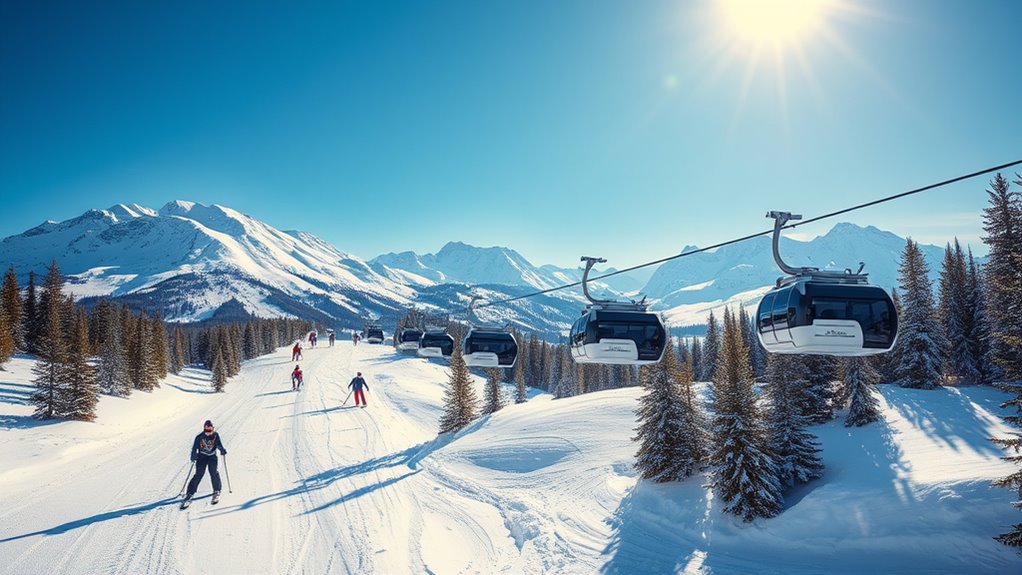
Visitors aiming for a sustainable experience in Aspen Snowmass have several transportation options that decrease environmental impact. Electric shuttle buses provide quiet, clean rides around the area, cutting emissions and easing congestion. Bike sharing programs allow you to explore the town and surrounding trails while staying eco-friendly. You can also take advantage of carpooling with fellow visitors, minimizing your carbon footprint. Walking is another great option, especially for short trips and scenic strolls. Additionally, many hotels offer shuttle services to major attractions, reducing the need for individual car use. These options make it easy to enjoy your trip responsibly and help preserve Aspen Snowmass’s natural beauty. Embracing these sustainable choices ensures you contribute to a greener ski season for everyone. Understanding the importance of Health – Greek Sceptic can also motivate visitors to adopt eco-friendly habits that benefit both personal well-being and the environment.
Eco-Friendly Infrastructure and Building Practices
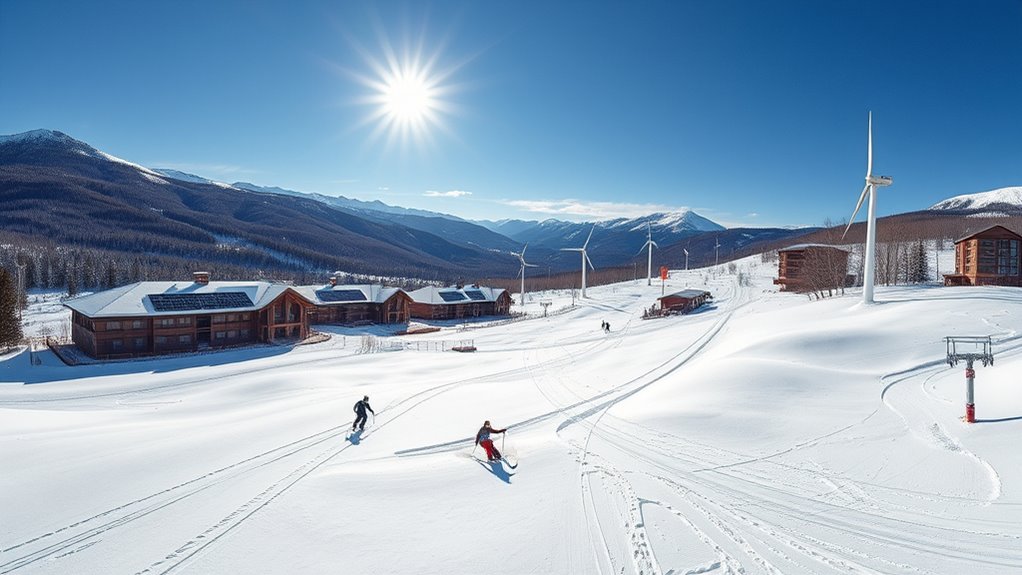
Implementing eco-friendly infrastructure and building practices is essential for reducing Aspen Snowmass’s environmental impact. By choosing eco conscious materials, you help minimize the use of harmful resources and promote sustainability. Green architecture principles guide the design of buildings that maximize energy efficiency, reduce waste, and lower carbon footprints. You can incorporate solar panels, efficient insulation, and natural lighting to make structures more sustainable. Opting for locally sourced, recycled, and non-toxic materials further supports eco-friendly goals. These practices not only reduce environmental harm but also create healthier spaces for visitors and staff. Embracing green architecture shows your commitment to protecting Colorado’s pristine landscape while maintaining world-class amenities. Your efforts contribute markedly to the ski area’s journey toward carbon neutrality. Additionally, understanding second trimester overview can help in planning sustainable accommodations that support maternal health and environmental responsibility.
Community Engagement and Conservation Efforts
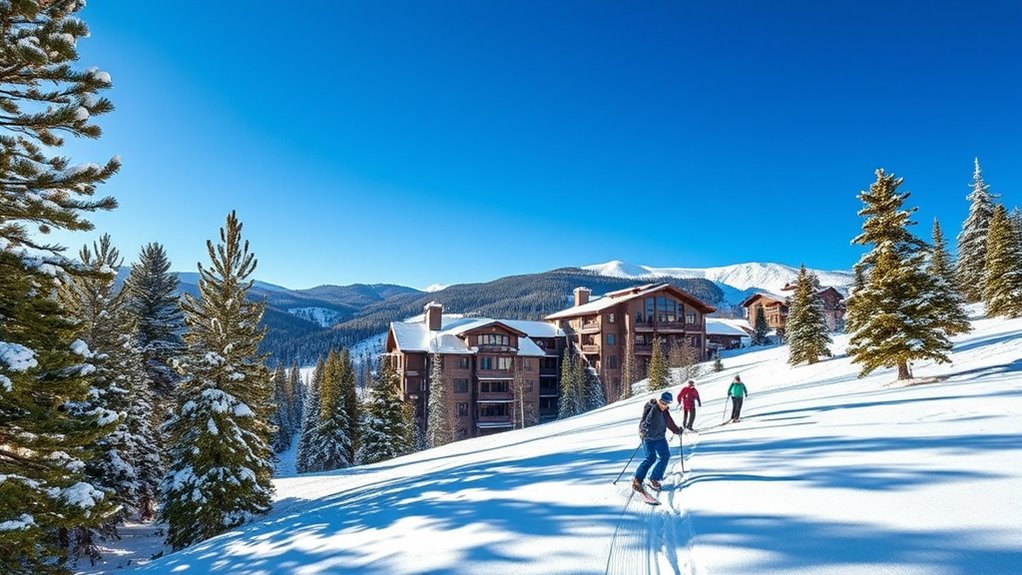
Building on eco-friendly infrastructure efforts, engaging the local community is key to fostering a sustainable future for Aspen Snowmass. You can participate in impactful local community partnerships and support conservation initiatives that protect the environment. Educational outreach programs are designed to inform residents and visitors about sustainability practices and the importance of conservation. By getting involved, you help create a shared responsibility for preserving the snow and natural beauty of the area. Consider these ways to contribute:
Join community efforts and support conservation to protect Aspen Snowmass’s natural beauty for future generations.
- Attend community sustainability events
- Volunteer for local conservation projects
- Promote eco-friendly practices among peers
- Support local businesses committed to sustainability
- Educate others about environmental impact
Implementing environmental benefits can further enhance the positive effects of community engagement and conservation efforts. Your active participation strengthens efforts to maintain Aspen Snowmass’s natural environment for generations to come. Together, community engagement and conservation efforts can truly make a difference.
The Future of Winter Sports in a Changing Climate
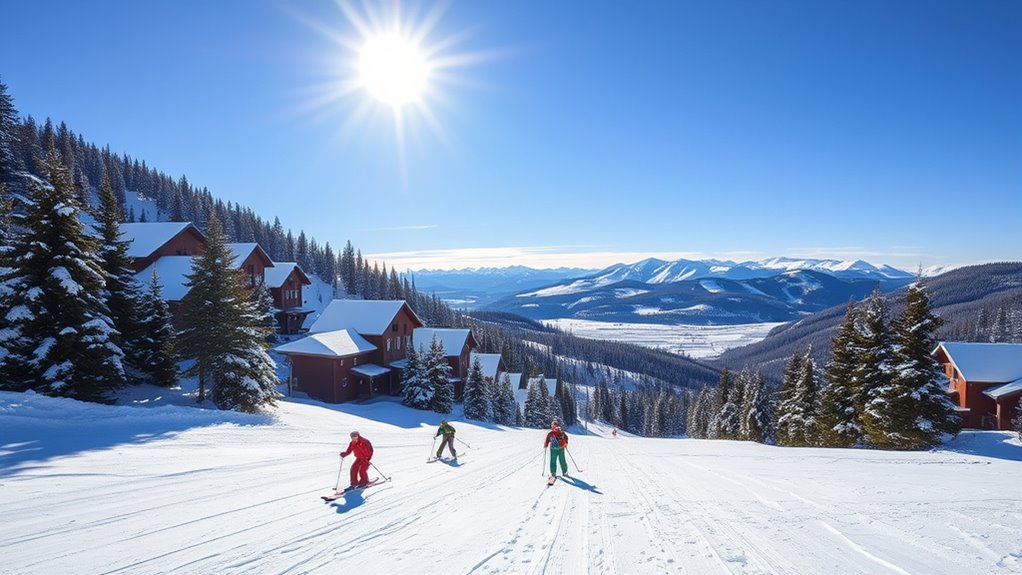
As climate change modifies winter conditions, you’ll see new sustainable practices shaping the future of skiing. Resilience strategies become essential to adapt to shifting seasons and unpredictable snow patterns. Embracing innovation now guarantees winter sports can thrive in a changing climate. The integration of emerging green technologies can further enhance sustainability efforts in winter sports.
Innovative Sustainable Practices
Innovative sustainable practices are transforming the future of winter sports in response to a changing climate. You can help protect alpine biodiversity and support snowpack preservation by embracing new technologies and methods. For example, resorts are implementing eco-friendly snowmaking that reduces water and energy use while maintaining quality. You might also see the adoption of renewable energy sources powering lifts and operations, decreasing carbon footprints. Additionally, efforts like habitat restoration protect local ecosystems. Some resorts are experimenting with artificial snow that minimizes environmental impact. Lastly, promoting responsible tourism encourages visitors to minimize their ecological footprint. These practices ensure winter sports remain viable, vibrant, and sustainable. Incorporating tableware innovations such as eco-friendly materials can further reduce environmental impact. By supporting and adopting these innovations, you directly contribute to preserving the natural beauty and resources that make skiing in Aspen Snowmass so special.
Climate Resilience Strategies
With climate change accelerating, ski resorts like Aspen Snowmass are adopting proactive strategies to guarantee winter sports remain viable in the future. One key approach is implementing adaptive infrastructure, such as snowmaking systems that use less water and energy, and designing slopes that can handle variable snow conditions. Additionally, resorts are investing in carbon offsetting projects, like reforestation and renewable energy, to counterbalance emissions from operations. These strategies help build resilience against unpredictable weather patterns and reduced snowfall. By integrating adaptive infrastructure and carbon offsetting, Aspen Snowmass aims to reduce its environmental impact while ensuring consistent skiing experiences. This proactive stance not only preserves winter recreation but also demonstrates a commitment to long-term sustainability amid a changing climate. Incorporating biodiversity conservation practices can further enhance ecosystem resilience and support local wildlife affected by climate change.
Shifting Winter Seasons
Shifting winter seasons due to climate change are already transforming the future of winter sports. Longer warm periods threaten snowpack preservation, reducing reliable skiing days. This shift impacts alpine biodiversity, disrupting habitats for native species. As seasons change, you might notice shorter winters and unpredictable snowfalls. To adapt, resorts are exploring new strategies, such as artificial snowmaking and diversifying seasonal activities. These efforts aim to extend the ski season and protect natural ecosystems. You can also support efforts to reduce greenhouse gases, helping slow these changes. Recognizing the importance of snowpack preservation and alpine biodiversity is key to maintaining winter sports for future generations. Adaptation and sustainability will be essential in ensuring winter sports remain part of Colorado’s landscape.
Frequently Asked Questions
How Does Carbon-Neutral Skiing Affect Overall Local Biodiversity?
You might wonder how carbon-neutral skiing impacts local biodiversity. By reducing greenhouse gases, it helps protect wildlife habitats from climate change effects. This sustainable approach minimizes habitat disruption, allowing plant diversity to flourish. Less pollution means healthier ecosystems, supporting a variety of species. So, your support for carbon-neutral skiing contributes to preserving the region’s natural balance, ensuring wildlife and plant life thrive for generations to come.
Are There Specific Certifications for Eco-Friendly Ski Resorts in Aspen Snowmass?
Imagine stepping onto snow as pure as a mountain stream—that’s what eco-friendly ski resorts aim for. In Aspen Snowmass, you’ll find resorts that carry eco label programs, showcasing their commitment to sustainability. These resorts meet strict certification standards, ensuring eco-conscious practices are in place. Look for official seals, and you’ll know you’re supporting places that prioritize environmental health, helping preserve Colorado’s breathtaking beauty for generations to come.
What Are the Economic Impacts of Sustainable Practices on Local Businesses?
You’ll notice that sustainable practices boost economic growth by attracting eco-conscious visitors who spend more locally. They also foster community engagement, encouraging collaboration among businesses, residents, and the environment. This creates a positive cycle, strengthening the local economy while promoting eco-friendly initiatives. By prioritizing sustainability, your community benefits from increased tourism, job opportunities, and a stronger sense of shared responsibility for preserving Aspen Snowmass’s natural beauty.
How Do Visitors Contribute to or Hinder Sustainability Efforts?
Imagine you’re stepping into a new era, like 2023 on a jetpack. Your visitor awareness greatly influences sustainability efforts—by choosing sustainable transportation options, you reduce carbon footprints and support local initiatives. However, if you’re unaware or indifferent, you hinder progress. Your actions, like carpooling or using eco-friendly shuttles, can boost sustainability, turning your visit into a positive force. Conversely, ignoring these practices stalls environmental progress.
What Innovative Technologies Are Being Explored for Future Green Ski Resorts?
You’re curious about future green ski resorts, right? They’re exploring innovative technologies like renewable energy sources—solar, wind, and geothermal—to power lifts and facilities sustainably. Eco-friendly infrastructure, such as energy-efficient buildings and water-saving systems, also plays a key role. These advancements aim to reduce environmental impact, making skiing more sustainable. By embracing these innovations, resorts can blend eco-consciousness with top-tier experiences, ensuring you enjoy winter sports while protecting the planet.
Conclusion
By choosing carbon-neutral skiing in Aspen Snowmass, you’re supporting a future where winter sports coexist with a healthy planet. Imagine a visitor who bikes to the slopes or stays in eco-friendly lodges, reducing their carbon footprint. Your choices matter—every effort contributes to combating climate change. Together, we can guarantee that generations to come can enjoy snowy adventures, just like you do today, in a sustainable and thriving mountain environment.

